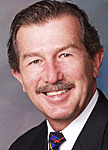Former Council Member Bob Binder opposes both options on the ballot for geographic representation
Monday’s lunchtime debate drew about 40 people to hear arguments for not just Propositions 3 and 4 on the November 6 ballot, but reasons why voters should once again turn thumbs down to both plans for geographic representation in City Council elections.

The program was hosted by the Central Texas Democratic Forum, emceed by attorney Chuck Herring of Herring & Irwin LLP.
Until this debate, virtually all discussions about how council members should be elected have focused on the problems with the current all-at-large system and advocated for one of two proposed plans for change.
Proposition 3 calls for electing 10 council members from geographic districts and only the mayor elected at-large. The 10-1 plan advocated by Austinites for Geographic Representation (AGR) includes an Independent Citizens Redistricting Commission to draw council districts the City Council would have no choice but to adopt.
Proposition 4 would have eight council members elected from geographic districts, and the mayor and two council members would be elected at-large. Council districts would be determined as directed by ordinance, the contents of which would be determined if this Proposition prevails.
If both propositions win voter approval the one that nets the most total votes wins and would be implemented, subject to approval of the U.S. Department of Justice, which oversees compliance with the Voting Rights Act.
The no-change advocate

Attorney Bob Binder of Bob Binder & Associates PC, who served on the City Council from 1973 to 1975 and ran unsuccessfully for mayor in 1981, thinks the election system ought to remain unchanged.
“What part of ‘no’ don’t you understand,” Binder said, citing six previous failed attempts to gain voter approval for some form of geographic representation on the City Council.
Following the talking points that he distributed before the program, Binder asked rhetorically, “Why give up access to seven council members for access to two or four?” if one of the two propositions on the ballot should succeed.
Binder claimed the so-called “gentlemen’s agreement”—in which white power brokers agreed that the council would have one black and one Latino member—is a “myth” and noted that minority members have been and are being elected at-large.
“If you liked redistricting on the state level,” he said, “you’ll love it on the local level. Who will serve on the commission? Where are the maps?” he asked, addressing questions that will not be specifically addressed unless and until Proposition 3 or Proposition 4 gains voter approval.
The concern over establishing a council district in which an African American could be elected is problematic, he said, because Austin is becoming more diverse and “people are living everywhere, the way we set out for Austin to be.”
The 10-1 advocate

Attorney Bill Aleshire of Riggs Aleshire & Ray PC, a former Travis County tax assessor and Travis County judge, said, “I view this Austin election for single-member districts to be a fundamentally important opportunity to make real the otherwise false image Austin has for being a ‘hotbed of democracy.'”
(Disclosure: Aleshire is The Austin Bulldog‘s attorney in two open-records lawsuits against the City of Austin.)
Aleshire said that city government is neighborhood-based and the city’s electoral process should, but does not, recognize this neighborhood orientation.
“When, over the last 40 years, more than one-half of the City Council members and 88 percent of the mayors have come from only four westside zip codes, the current at-large system—inspiring a whopping 8 percent voter turnout—has not produced anything close to neighborhood representation.”
He said the “insider’s 8-2-1 plan” is designed to protect as much of the current system as possible, “but having that plan on the already complicated November ballot is likely to hurt our chance to get neighborhood representation at all.”
Unlike Binder, Aleshire believes there was a “gentlemen’s agreement” to permit one black and one Hispanic on the council and he called that arrangement undemocratic and “another expression of bigotry that does not get enough exposure.”
Recalling that San Antonio Mayor Julian Castro made a speech at the Democratic National Convention last week, Aleshire said he wondered if Castro would have been elected mayor had he been forced to run at-large for the council seat he won before running for mayor. But Castro, like former San Antonio Mayor Henry Cisneros, was first elected to a city council seat from one of the 10 geographic districts in the Alamo City, Aleshire said.
Aleshire said having council members elected from districts creates opportunity for candidates to win with a grass-roots campaign and makes it more likely the council members will better understand the perspective of their district residents.
“Having a council with members from diverse perspectives, challenged to arrive at decisions for the common good, is healthy, smart, and more representative of the whole city….”
Aleshire said, “Unlike the politician’s 8-2-1 plan, the people’s 10-1 plan was the result of the council’s own process for recommendations from a citizen’s commission—chaired by (retired State Senator) Gonzalo Barrientos—as well as a subsequent petition drive, with over 22,000 signatures of Austin voters, that has achieved unprecedented board-based support. No such petition or broad coalition was present in past elections on single-member districts in Austin.”
The 8-2-1 advocate

Longtime political consultant David Butts noted he was on the council-appointed 2012 Charter Revision Committee and said he had taken part in—and supported—all six opportunities to change the system from all-at-large council when some form of geographic representation was put before voters.
Butts outlined how Austin got the at-large election system through the unsuccessful but remarkable showing of Arthur DeWitty, an African American, in the 1951 council election.
The City Clerk’s Election History website shows that in a time when all City Council candidates ran together, the top five vote getters took council seats, and then among themselves elected the mayor, DeWitty placed eighth, taking 3,636 votes in the 1951 election. The fifth-highest candidate in that election garnered 6,214 votes.
Although DeWitty fell well short of the total needed to get elected, Butts said the council got the City Charter changed to implement the at-large system and thereby prevent minority members from being elected. That strategy succeeded until 1971 when African American Berl Handcox was elected. In 1973, John Trevino Jr. became the first Latino elected to the council.
In early elections offering the opportunity for voters to approve geographic representation, Butts said the opposition came from the Austin Chamber of Commerce and the Austin American-Statesman.
“The Chamber thought the system worked just fine for them, so why change?”
Butts said this coming election will be the first opportunity to vote for geographic representation in a November election.
“My first interest is to change from the all-at-large system we have,” Butts said. “I looked at the all-at-large and all-single-member districts and I chose the middle path (the 8-2-1 hybrid). It provides checks and balances.”
He added that, “No system is better than the people elected to it.”
Butts warned that a majority vote is needed to implement either proposition for geographic representation and “35 percent of voters do not support any change whatsoever.”
Regarding the “abysmal turnout” that Aleshire alluded to, Butts said that would change if voters approve the charter amendment to move elections from May to November.
“The two groups for change could not come together,” Butts said. “We got no response from the other side (Austinites for Geographic Representation), which I thought was politically unwarranted.”
He did not mention that Austinites for Geographic Representation had been working for nearly a year and that a petition drive for the 10-1 plan was well underway before overtures for compromise were made.
“One of my greatest concerns is that if I support someone who loses (the election under the 10-1 plan) … I’m basically cut out,” Butts said.
He said he had called members of Congress that did not represent his district and been told to call his own representative. “That’s what will happen with this system,” Butts warned. “When you create a district system there will be a ‘ward courtesy’ effect among many of the council members. There needs to be people looking after the overall community.”
“The hybrid system has the potential—and it’s only a potential—to create balance,” he said.
Point-counterpoint
Each panelist was given a minute to respond to the presentations.
Binder said he believed that electing council members from geographic districts would have little effect on voter turnout, and added, “Ward courtesy is alive and well in virtually every place (districts are) used. A congressman’s website will not even take my e-mail if I’m not in his district.”
Aleshire said that, “Wheeling and dealing among council members goes on now. Is it ward politics, or coalition building?”
He said that council members would be “more empathetic” if they live in your district than if they live in the “fiefdom of West Austin.”
Butts said turnout will be greatly improved if voters okay moving elections from May to November (as proposed by Propositions 1 and 2). “Creating single-member districts by themselves would bring a small increase.”
Butts said if elections are moved to November a lot more people will be voting and even geographic districts will have “25,000 to 35,000 people voting in the same district,” so it will cost more to campaign.
Audience Q&A

Attorney Fred Lewis drafted the rules for drawing council districts that would be followed in forming and using an Independent Citizens Redistricting Commission, which is part of the 10-1 plan (Proposition 3). He noted that the 8-2-1 plan (Proposition 4) provides “no guidance or criteria” for drawing council districts and asked “which is better, and why?”
Aleshire noted that attorney Dave Richards (of Richards Rodriguez & Skeith LLP) supports the 10-1 plan and said it was best to ensure minority representation. “The council left a blank slate for their proposition,” while the independent commission would do “what’s best for the people in the districts.”
Butts said he had talked to Dave Richards and, “He told me the 8-2-1 plan would pass muster” (under the Voting Rights Act). (Austinites for Geographic Representation has contended that the 8-2-1 plan would not be legal under the Voting Rights Act.)
“The Travis County Republican Party supports 10-1,” Butts said, portraying that as a negative, rather than an indication of the broad coalition supporting the 10-1 plan.
Butts said he realized that under the 8-2-1 plan politicians would be involved in deciding council boundaries, but added that what the independent commission draws neither politicians nor voters would have control over.
“The independent commission has no accountability. It’s a Rube Goldberg system they came up with,” he said, referring to the cartoonist “best known for a series of popular cartoons depicting complex gadgets that perform simple tasks in indirect, convoluted ways.” (The independent commission is modeled on a system already in use in California.)
Regarding how the City Council might direct the drawing of council districts should the 8-2-1 gain a majority voter approval and get more votes than the 10-1 plan, Butts said, “The City Council will do just what it did with the Charter Revision Committee.”
To which Aleshire shot back, “Ignore it,” drawing a burst of laughter from the audience.
Aleshire’s quip was based on the fact that the Charter Revision Committee voted to recommend the 10-1 plan be put before voters, yet the council added the 8-2-1 plan alternative.
Want more information?
Then attend tonight debate hosted by Southwest Key’s VOTA! Campaign, an East Austin voter mobilization initiative. (Click link for event details.)
Or visit the websites of the proponents for the two propositions:
Proposition 1—Austinites for Geographic Representation
Proposition 2—Austin Community for Change
Read Bob Binder’s talking points and the text of his Statesman op-ed article
Read Bill Aleshire’s prepared speech
This report was made possible by contributions to The Austin Bulldog, which operates as a 501(c)(3) nonprofit to provide investigative reporting in the public interest. You can help to sustain The Austin Bulldog’s reporting by making a tax-deductible contribution.
Related Bulldog coverage:
The Election Wars Have Begun: Interest in how council members elected running high, as face-off debates abound, September 9, 2012
8-2-1 Near Certain to Go on Ballot: City Council Votes on Second Reading to Put Competition Election Plan on Ballot, July 31, 2012
Hard Fought, Heartfelt Charter Decision: Charter Revision Committee Votes 8-7 to Back 10-1 Plan for Council Elections, February 3, 2012
New Restrictions Proposed for Lobbyist Fundraising: Lobbyists Can Only Give Candidates $25 But Can Collect Unlimited Contributions For Them, January 22, 2012
Committee Debates How to Elect Council: Charter Revision Committee Divided Over Pure Districts vs. Hybrid System, January 9, 2012
Thirteen Charter Changes and Counting: Charter Revision Committee’s Next Job: Tackle Plan for Geographic Representation, December 14, 2011
Council Confirms November 2012 Election Date for Charter Amendments: Resolution Ensures Citizens Initiative Won’t Force May 2012 Charter Election, November 3, 2011
Coalition Launching Petition Drive to Get on the Ballot for May 2012 Election, October 18, 2011
Broad Community Interest Focusing on How Mayor and Council Members Elected, October 4, 2011
Coalition Nearing Petition Launch for Grass-roots Council District Plan, August 24, 2011
Maps Prove Select Few Govern Austin: Forty Years of Election History Expose Extent of Disparity, August 4, 2011
Petition Launch Imminent to Force Election for Geographic Representation in City Elections, March 7, 2011







